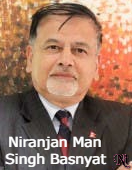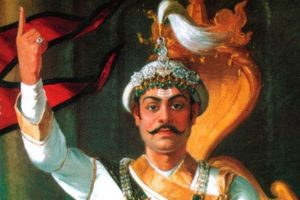-Dr. Niranjan Man Singh Basnyat
Nepal

Begin text:
In 2019, I published a book entitled “Role of Shreepali Basnyat in the Unification of Nepal,” in which I traced my own family’s contributions to Nepal’s unification campaign. For that project, I conducted extensive research based on secondary sources, particularly books, articles and historical documents available in Kathmandu’s various libraries.
My reliance on secondary information stemmed from the fact that primary historical information is difficult to find in Nepal today. What remains is in the form of some unpublished Rukka or Laal Mohar (Orders), or some anecdotes still circulating in the homes of descendants of ancient courtiers.

Prithvi Narayan Shah said that ‘when old men die, information goes down to the next generation.’ However, with the passage of time, valuable historical information, especially from the era of Nepal’s unification (1744-1813 AD), is getting lost despite its extraordinary importance to the country. As a result, it has become my hobby to collect and compile information from that era whenever possible.
During my research process, I found myself thinking about the leadership of King Prithvi Narayan Shah, his decision-making, and his thought process. He was a visionary leader who was able to translate his lofty ambitions into reality in his own lifetime. The project he imagined and brought to fruition, still survives in the form of modern Nepal—an independent, sovereign, and unified nation even after 252 years. All Nepalis should be proud of this.
However, for those who are unfamiliar with the unification history of Nepal, this book provides them with a detailed timeline of Prithvi Narayan Shah’s campaign and dedication. Hopefully, after reading this book, my intention is that people will be able to learn and appreciate his hard work.
I would like to emphasize at the outset that this book does not attempt to provide a comprehensive biography of Prithvi Narayan Shah or his conquests. Such an undertaking would take several volumes. The main purpose of this book is to provide the reader with basic facts, a timeline of events, and Prithvi Narayan Shah in his own words as translated into English, French, and Spanish.
I have also avoided the use of extensive footnotes or endnotes to facilitate readability. If readers wish to understand the topic in greater detail, I recommend the works of various historians who have written extensively on the issue, including Surya Bikram Gyawali, Baburam Acharya, Yogi Naraharinath, Nayaraj Pant, Mahesh C. Regmi, Gyanmani Nepal, Dhanabajra Bajracharya, Ludwig F. Stiller, Dr. Maheshraj Pant, and Sujit Mainali, among others.
In addition, this book does not attempt to undertake a moral assessment of Prithvi Narayan Shah or his conduct. The “founding fathers” of many countries—ranging from Gandhi in India, to Ataturk in Turkey, to the founders of the United States—were all complex and deeply flawed men.
If we judge Nepal’s first king with our modern democratic sensitivities, readers may find his words anachronistic, to put it mildly. Likewise, as with every conqueror, the campaign led by Prithvi Narayan Shah and his troops will be interpreted differently by different communities—it may be a patriotic unification campaign for some and a campaign of repression for others. However, it is my belief that despite his many shortcomings, the words of Prithvi Narayan Shah in the Counsel (popularly known as Dibya Upadesh or Divine Counsel) acted as Nepal’s first de facto constitution and was used for generations by his courtiers and average citizens to lay the building blocks for what has become modern Nepali society in all its strengths and flaws. For this reason alone, understanding Nepal is impossible without understanding Prithvi Narayan Shah. And thus, familiarizing ourselves with Nepal’s founder and his words—direct and without interpretation—is imperative.
In writing this book, I have made several strategic decisions, which I believe will benefit the reader. In the analytical overview section, where I explain details about the Counsel, readers may find some phrases repetitive. This is because in the translation of the original text into English, I have tried to simplify difficult sentences so that every reader can easily understand the meaning inherent in the original text of the Counsel. In the conclusion section, views of many scholars on different aspects of King Prithvi Narayan Shah’s life and character have been presented and analyzed. Nepal’s relations with many countries of the world have also been explained in brief. Various countries’ interference in the internal affairs of Nepal have been discussed so that readers can compare the situation at the time of King Prithvi Narayan Shah to the situation now. I believe this demonstrates Prithvi Narayan Shah’s understanding of foreign affairs and shows how Nepal’s first king was as vigilant of external threats as many citizens are today.
Some annexes have been added to give more information about the period of his reign and his family life. An original Nepali text of the Counsel has been provided in Annex-VI for the Nepali readers. This text has been also divided in 52 paragraphs and given numbers to facilitate the readers’ ability to refer to the corresponding translated paragraphs in English, French, and Spanish.
Aglossary, necessary for our foreign readers who may not understand our various words used in administrative documents of that era, is also provided. The readers in French and Spanish languages are advised kindly to consult Bibliography at the end of the English Chapter.
I felt it worthy to give some detail regarding Bakhat Man Singh Basnyat, who actually discovered the original text of the Counsel in , which was built by his ancestor Kazi Abhiman Singh Basnyat. The original text of the Counsel is available at the National Archives of the Government in Ram Shah Path, Kathmandu. Maan Mandir or Tilanga GharThe achievement of Bakhat Man Singh Basnyat in discovering the text is in itself a moment of historical importance for Nepal. If he had not discovered the text, we would not have known many facts about Nepali history.
During my diplomatic training and various assignments abroad in Nepalese Embassies in my 31-year career as a diplomat, I had the opportunity to learn two other important languages besides English: French and Spanish. I did an intensive French language course in Vichy, a historic small city of France and a Master’s degree in international relations course in Paris from 1988 to 1989.
Though I already had a fairly good understanding of Spanish language with a certificate of Campus of International Languages, Tribhuvan University, in 1984, I had the opportunity to undergo an internship in the French Embassy at Buenos Aires in Argentina for two months in 1989 as part of the course. Thus I decided to venture into translating the ‘Counsel of King Prithvi Narayan Shah’ into these three global languages so that future generations of Nepalis and foreigners interested in Nepal can assess and understand the founder of Nepal in his own words.
In course of translations from English to French and English to Spanish, I encountered several difficulties to find the appropriate words in those two languages for some of the English words.
While translating the text to French, I remembered my friend Mr. Ram Chapagain, who had been living in France for nearly four decades. I requested him to translate the text of the Counsel to French which he accepted instantly because of his own interest in history. I thank him for accepting this task. Last, but not least, I would like to thank my wife Renu, son Nishchal Man Singh Basnyat JD and my daughter Dr. Bonita Singh Basnyat for helping me in this endeavour. Similarly, I am grateful to my cousin Bijendra Man Singh Basnyat for his help in lending me some of his computer knowledge and skills. Despite the generosity and help of others, any errors or omissions in the book are my sole responsibility.
I hope that people will enjoy this re-introduction of King Prithvi Narayan Shah in English, French, and Spanish. I have tried to explain the Counsel as per the emotions and sentiments of the king. I am hopeful that this book will take Nepal’s history of unification and the words of its founder to both an international audience and the next generation of Nepalis.
Text courtesy: From the ‘preface’ of the book by Ambassador Basnyat.
# We will publish the Divine Counsel in parts every week: Ed. Upadhyaya.
# The author was Nepal’s Ambassador to Malaysia.
# For any queries about the book, please email the author at niranjanbasnyt@gmail.com
# The book was published on the auspicious occasion of the 299th Birth Anniversary of King Prithvi Narayan Shah, the founder of modern Nepal.
# Our contact email address is: editor.telegraphnepal@gmail.com
